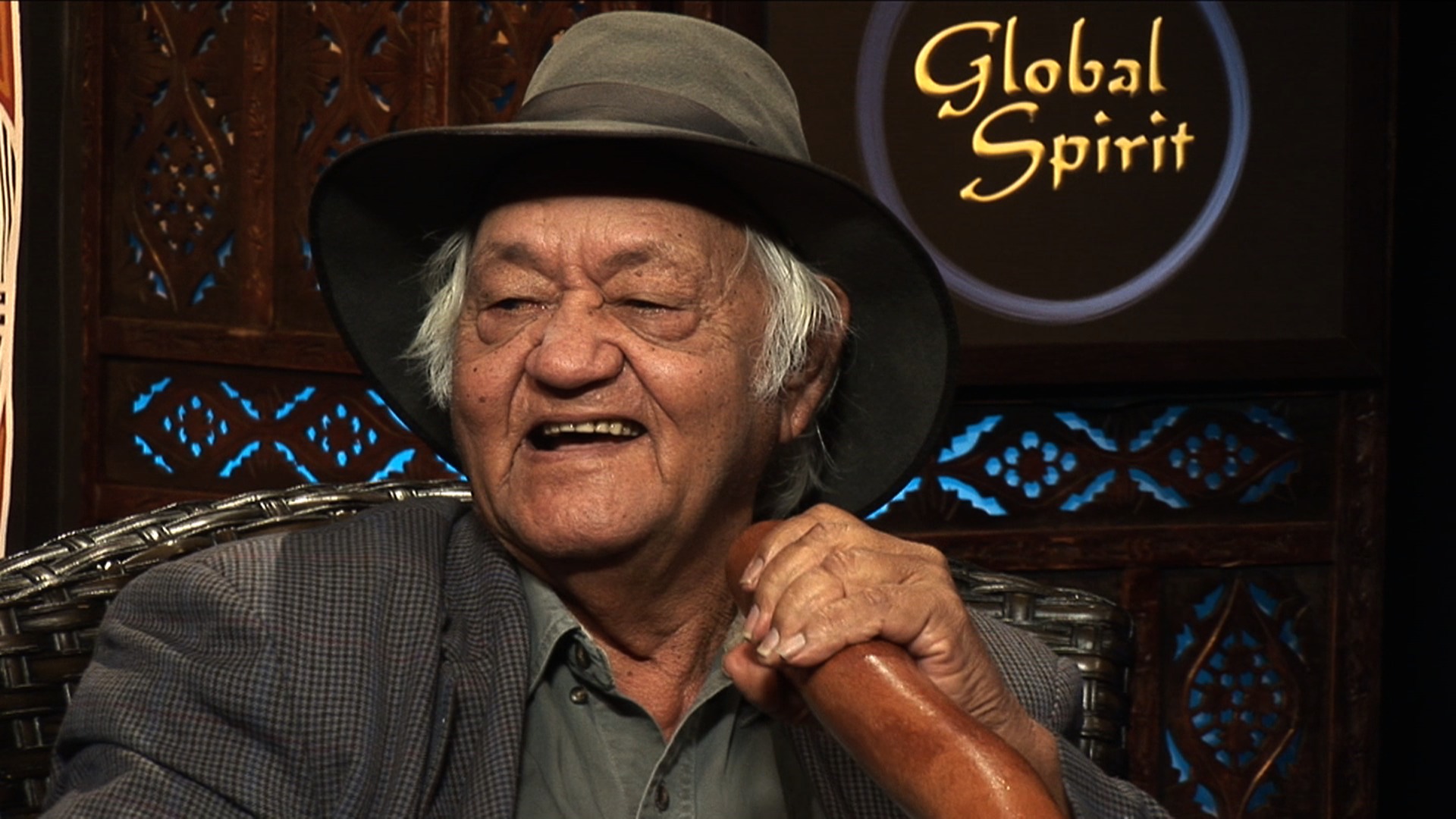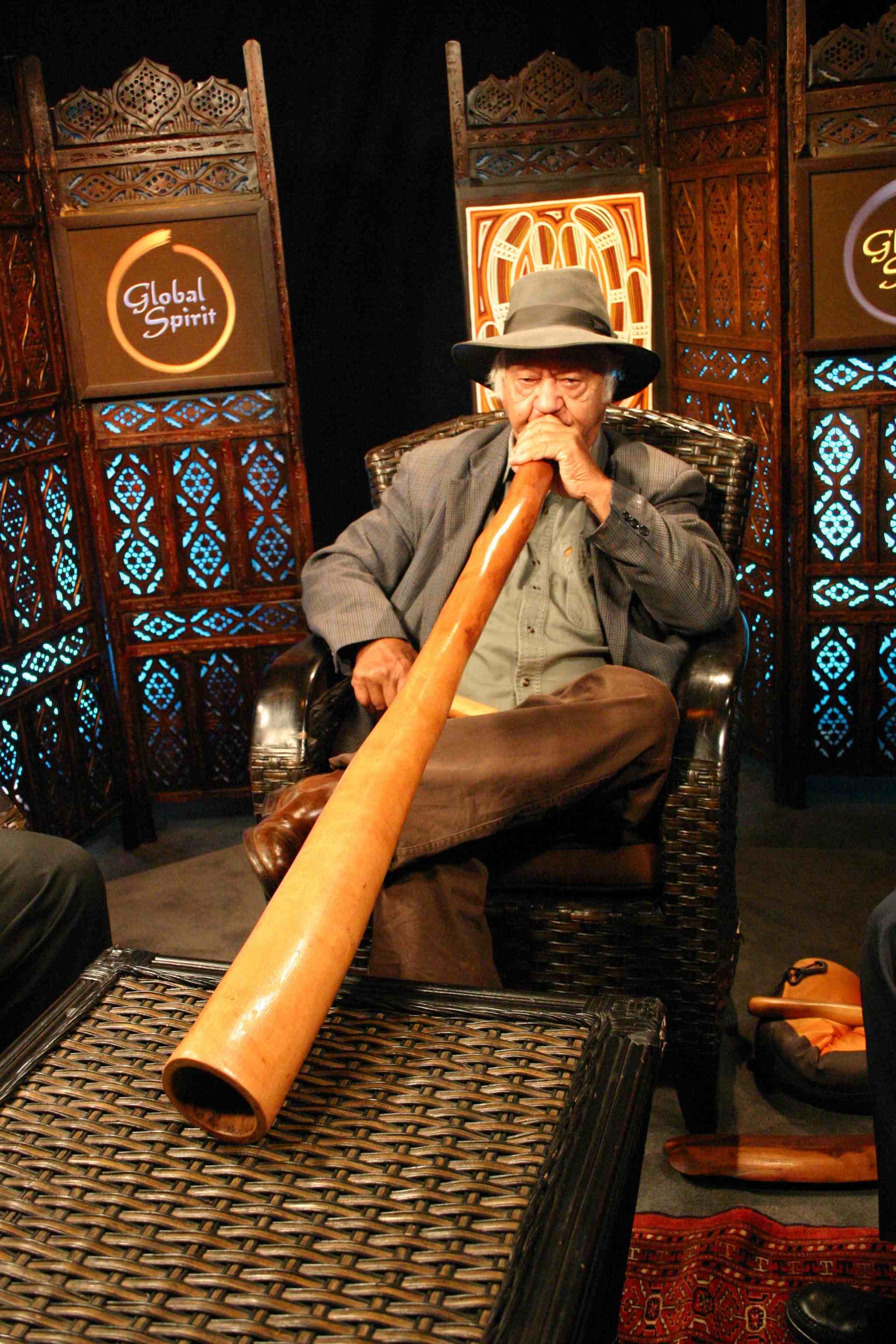
Understanding the cosmology and creation stories that underlie the Australian aboriginal "Dreamtime" is often a challenging stretch for the western mind. Perhaps this is why we knew that having an aboriginal guest on the Global Spirit series was important. For more than a year we had dreamed of finding a true aboriginal "elder," someone who would not only carry the full wisdom tradition of the culture and the "Dreamtime," but also be able to express some of its core features to the outside world.
As we were already dreaming, we let ourselves go on to dream that such an aboriginal elder might also be an artist and paint imagery inspired by, and drawn from that Dreamtime. On top of it all, such a person would need to be willing to travel from the Australian outback to San Francisco to be part of our program.
Finally meeting Yidumduma Bill Harney, a talented artist and Dreamtime authority, was therefore a dream come true. We met at the Miyako Hotel, just after Bill's arrival in San Francisco. As we sat in his hotel room and spoke for the first time, I remember wondering just how much aboriginal wisdom Bill would be willing to share with this "white-fella filmmaker," as he initially called me. I was well aware that in aboriginal culture, there are guarded traditions, severe taboos and other cultural responsibilities to consider before an elder decides to release aboriginal wisdom or teachings to the outside world.
After a couple of hours talking with Bill and listening to his stories, all seemed to be going well. This was due in small part to our honest respect for aboriginal culture, but even more-so to Paul Taylor, Bill's friend and cross-cultural translator, who told Bill that the Global Spirit series could be trusted to not offend or misrepresent the aboriginal world. This trust deepened the next morning after Bill met our program host Phil Cousineau, which in turn allowed Global Spirit to enter the animated and spirited aboriginal world of Bill Harney:

"There are spiritual (entities) throughout the country ... sometimes they are in the desert, sometimes in the river-land, wherever they want to gather. These spiritual people are on the water-bank, where they stay in little caves. There are spiritual beings all over, and they're all helping. They're all good spirits, reminding you of what to do, where to go, where to sleep, how to fix everything, and care for everything. ... And we know that they all were created back in the Dreamtime. Everything was created back in the Dreamtime. That's what the European doesn't understand ... white people don't understand. And that's why people like us, we really need to teach about this sort of thing." -- Bill Harney
Fortunately, our other program guest, dream expert and clinical psychologist Dr. Stephen Aizenstat, had spent some weeks comparing dream-notes with aborigines in the Northwest Territories some years before. Steve's provocative concept of "Dream Tending" and his engaging explanations of the dream state, visual imagery and metaphor, though clearly coming from the western, Jungian-influenced world, were not at all antithetical to Bill's:

"When we take the time to listen, to really be present and allow the dream images to come forward and present themselves, there is a certain intelligence that lives in the image itself. And rather than us trying to figure out 'What does this dream mean?' ... or deciding: 'That person is just delusional and is having a dream and needs medication,' we find that sometimes just the opposite is true. The visitations or the figures or the spiritual guides that are in the dream actually have something to say ... something ... either a warning, or guidance, or something constructive, something useful. It's the way that we listen that makes all the difference in the world. Taking the time to listen first, before we so quickly come in to analyze or interpret." -- Dr. Stephen Aizenstat

But hearing Bill play the didgeridoo, then hearing about the intricacies of the Dreamtime, with frequent references to creatures like "Willie Wagtail" and the tail of the Long Tail Pheasant (that grew into the didgeridoo, back during the Dreamtime), prompted our host to ask:
"Bill, do you think we live in two different realities? I mean, do the Aboriginal and the European live in the same world or are we really in two different worlds?"
"Well we're more or less in the same world, alright, but the European and the Aborigines have a different way of understanding," Harney said. "The Aborigines have the strong power to understand how it is all related, while the Europeans, they can try to understand what it all means."
Remembering those early wild dreams of ours, to have an aboriginal elder's perspective on Global Spirit, it seemed Bill Harney's answer somehow said it all.
The following two video sequences, which underscore some of the differences in the "two worlds," are from the GLOBAL SPIRIT program: DREAMS, VISIONS AND REALITIES, now showing on many public TV stations (check local broadcast schedules at www.GlobalSpirit.tv.
GLOBAL SPIRIT is a unique inquiry into humankind's belief systems, wisdom traditions, and states of consciousness. Presented by British actor-comedian John Cleese and hosted by author and spiritual seeker Phil Cousineau, this new series takes viewers on a mind and soul-expanding journey, exploring the relationships between ancient wisdom traditions, diverse belief systems, world religions, metaphysics and modern science.